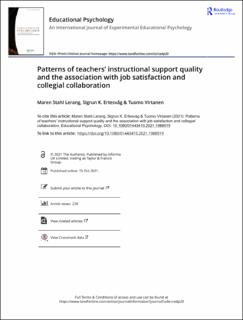| dc.contributor.author | Lerang, Maren Stahl | |
| dc.contributor.author | Ertesvåg, Sigrun K. | |
| dc.contributor.author | Virtanen, Tuomo Erkki | |
| dc.date.accessioned | 2021-10-20T13:52:42Z | |
| dc.date.available | 2021-10-20T13:52:42Z | |
| dc.date.created | 2021-10-17T11:23:48Z | |
| dc.date.issued | 2021-10 | |
| dc.identifier.citation | Lerang, M.S., Ertesvåg, S.K., Virtanen, T. (2021) Patterns of teachers’ instructional support quality and the association with job satisfaction and collegial collaboration. Educational Psychology | en_US |
| dc.identifier.issn | 0144-3410 | |
| dc.identifier.uri | https://hdl.handle.net/11250/2824204 | |
| dc.description.abstract | Classroom observations and teacher reports were used to investigate patterns of instructional support quality and the association with job satisfaction and collegial collaboration. Eighty-one Norwegian lower secondary schoolteachers participated in the study. Latent profile analysis (LPA) identified five profiles: confident (n = 21), low-quality (n = 21), less confident (n = 18), high-quality (n = 9), and low analysis and inquiry (AI) and instructional dialogue (ID; n = 12). The results indicated that the low-quality profile teachers were less satisfied with their job compared with the high-quality and low AI and ID profile teachers. By gaining more knowledge about patterns of instructional support quality and the associations with teachers’ job satisfaction and collegial collaboration, actions to support teachers’ professional development can be tailored to individual teachers’ needs. | en_US |
| dc.language.iso | eng | en_US |
| dc.publisher | Informa UK Ltd. (Taylor & Francis) | en_US |
| dc.rights | Attribution-NonCommercial-NoDerivatives 4.0 Internasjonal | * |
| dc.rights.uri | http://creativecommons.org/licenses/by-nc-nd/4.0/deed.no | * |
| dc.subject | utdanningsvitenskap | en_US |
| dc.subject | lærere | en_US |
| dc.title | Patterns of teachers’ instructional support quality and the association with job satisfaction and collegial collaboration | en_US |
| dc.type | Peer reviewed | en_US |
| dc.type | Journal article | en_US |
| dc.description.version | publishedVersion | en_US |
| dc.rights.holder | © The Author(s) 2021 | en_US |
| dc.subject.nsi | VDP::Samfunnsvitenskap: 200::Pedagogiske fag: 280 | en_US |
| dc.source.journal | Educational Psychology | en_US |
| dc.identifier.doi | 10.1080/01443410.2021.1988519 | |
| dc.identifier.cristin | 1946473 | |
| dc.relation.project | Norges forskningsråd: 238003 | en_US |
| cristin.ispublished | true | |
| cristin.fulltext | original | |
| cristin.qualitycode | 2 | |

